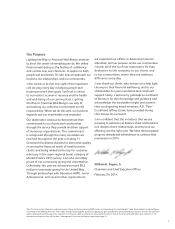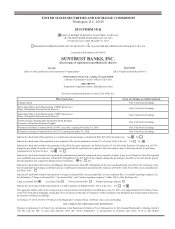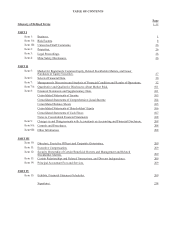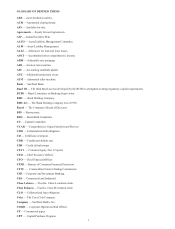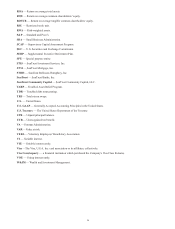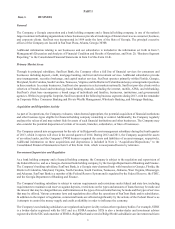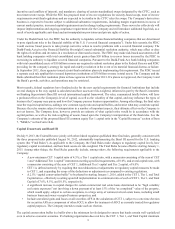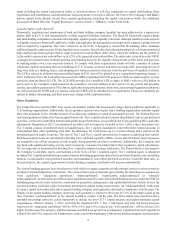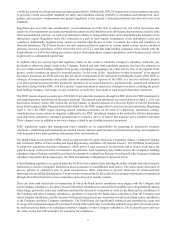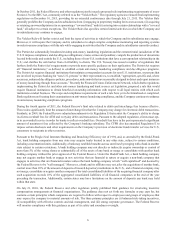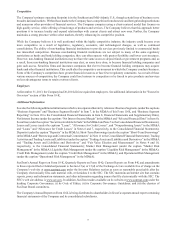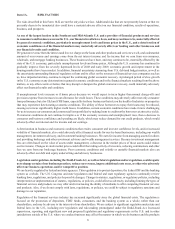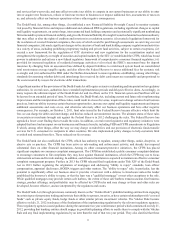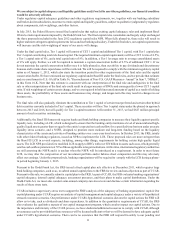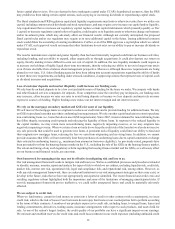SunTrust 2013 Annual Report Download - page 19
Download and view the complete annual report
Please find page 19 of the 2013 SunTrust annual report below. You can navigate through the pages in the report by either clicking on the pages listed below, or by using the keyword search tool below to find specific information within the annual report.3
incentives and conflicts of interest), and mandatory clearing of certain standardized swaps designated by the CFTC, such as
most interest rate swaps. While the SEC has proposed most of its core regulations for security-based swaps, most of its new
requirements await final regulations and are expected to be similar to the CFTC rules for swaps. The Company's derivatives
business is expected to become subject to additional substantive requirements, including margin requirements in excess of
current market practice, increased capital requirements and exchange trading requirements. These new rules collectively will
impose implementation and ongoing compliance requirements for the Company and will introduce additional legal risk, as a
result of newly applicable anti-fraud and anti-manipulation provisions and private rights of action.
Under the Dodd-Frank Act, the FDIC has the authority to liquidate certain financial holding companies that are determined
to pose significant risks to the financial stability of the U.S. (“covered financial companies”). Under this scenario, the FDIC
would exercise broad powers to take prompt corrective action to resolve problems with a covered financial company. The
Dodd-Frank Act gives the Financial Stability Oversight Counsel substantial resolution authority, which may affect or alter
the rights of creditors and investors in a resolution or distressed scenario. The FDIC may make risk-based assessments of all
bank holding companies with total consolidated assets greater than $50 billion to recover losses incurred by the FDIC in
exercising its authority to liquidate covered financial companies. Pursuant to the Dodd-Frank Act, bank holding companies
with total consolidated assets of $50 billion or more are required to submit resolution plans to the Federal Reserve and FDIC
providing for the company's strategy for rapid and orderly resolution in the event of its material financial distress or failure.
In September 2011, these agencies issued a joint final resolution plan rule implementing this requirement. The FDIC issued
a separate such rule applicable to insured depository institutions of $50 billion or more in total assets. The Company and the
Bank submitted their first resolution plans to these agencies in December 2013. If a plan is not approved, the Company’s and
the Bank’s growth, activities, and operations may be restricted.
Most recently, federal regulators have finalized rules for the new capital requirements for financial institutions that include
several changes to the way capital is calculated and how assets are risk-weighted, informed in part by the Basel Committee
on Banking Supervision's Basel III revised international capital framework. The rules, summarized briefly below, will have
a profound effect on the Company's level of capital, as well as the volatility of that capital, and may influence the types of
business the Company may pursue and how the Company pursues business opportunities. Among other things, the final rules
raise the required capital ratios, adding a new common equity ratio and capital buffers, and restrict what may constitute capital.
Because the rules remain subject to interpretation in a number of important aspects, their ultimate effect on the Company is
not yet known. The Company does, however, provide an estimate of what capital ratios would be in accordance with the
capital portion, as well as the risk-weighting of assets, based upon the Company's interpretation of the final rules. See the
Company's estimate of the proposed Basel III common equity Tier 1 capital ratio in the "Capital Resources" section of Item
7, "MD&A," in this Form 10-K.
Capital Framework and Basel III
On July 9, 2013, the Federal Reserve jointly with other federal regulators published three final rules, generally consistent with
the three proposed rules published August 30, 2012, substantially implementing the Basel III accord for the U.S. banking
system (the “Final Rules”). As applicable to the Company, the Final Rules make changes to regulatory capital levels, how
regulatory capital is calculated, and how bank assets are risk-weighted. The Final Rules become effective starting January 1,
2015. Among other things, the Final Rules generally include, among others, the following requirements applicable to the
Company:
• A new minimum CET 1 capital ratio of 4.5%; a Tier 1 capital ratio, with a numerator consisting of the sum of CET
1 and “Additional Tier 1 capital” instruments meeting specified requirements, of 6.0%; and a total capital ratio, with
a numerator consisting of the sum of CET 1, Additional Tier 1 capital and Tier 2 capital, of 8.0%.
• CET 1 is defined narrowly by requiring that most deductions or adjustments to regulatory capital measures be made
to CET 1, and expanding the scope of the deductions or adjustments as compared to existing regulations.
• A 2.5% “capital conservation buffer” to be phased-in starting January 1, 2016, added to the CET 1, Tier 1, and Total
Capital ratios , effectively resulting upon full implementation in a minimum ratio of each of CET 1, Tier 1, and Total
Capital of 7.0%, 8.5%, and 10.5%, respectively;
• A significant increase to capital charges for certain commercial real estate loans determined to be “high volatility
real estate exposures” not involving a down payment of at least 15% of the “as completed” value of the property,
which would apply, subject to certain exceptions, to a large array of commercial real estate loans, including small
business loans and owner-occupied business properties; and
• Include unrealized gains and losses on all securities AFS in the calculation of CET 1, subject to a one-time election
for securities AFS as a component of other AOCI, to allow the treatment of AOCI as currently treated for regulatory
capital purposes. The Company intends to make such an election.
The capital conservation buffer is a buffer above the minimum levels designed to ensure that banks remain well-capitalized
even in adverse economic scenarios. If a banking organization does not have the CET 1, Tier 1, and Total Capital minimum


